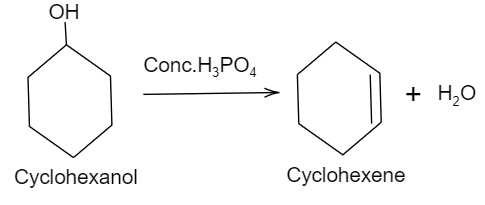
Answer
448.8k+ views
Hint: To find the answer of this question, remember by using an acid catalyst (such as strong concentrated acids, like sulphuric acid) as a reagent, an alcohol can be converted to an alkene. So, try to look at each option and choose the option which suits the criteria.
Complete step by step answer:
As we know, alcohol upon reaction with protic acids or acid catalysts (such as sulphuric acid or phosphoric acid) tends to lose a molecule of water and further form alkenes. These types of reactions are called dehydrogenation or dehydration of alcohols. It is an example of an elimination reaction.
Dehydration of alcohols follows a three-step mechanism:
-Formation of protonated alcohol,
-Formation of a carbocation, and
-Formation of alkenes.
So, here in the given question, let us see which option suits as a strong concentric acid which will act as a catalyst in the reaction of converting the cyclohexanol (which is an aromatic alcohol) to cyclohexene (which is an aromatic alkene).
So, here looking at each option, the option with $Conc.{{H}_{3}}P{{O}_{4}}$ is found to be a protic and a strong acid. This acid is generally used in the dehydration reaction of alcohols. Here, the acid protonated the $-OH$group present in the cyclohexanol because $-OH$ is a strong base making it a poor leaving group. Once the hydroxyl group has been protonated to ${{H}_{2}}O$, it now leaves and the nucleophile will obstruct beta hydrogen to form a carbon double bond or an alkene i.e. cyclohexene.

Concentrated phosphoric acid is a good dehydrating agent which converts an alcohol to an alkene by promoting the reaction but not consuming it while other options given are all nucleophiles, which will convert alcohols to alkyl halides.
So, the correct answer is “Option C”.
Note: Phosphoric acid is also called as orthoboric acid and is a weak acid with the chemical formula ${{H}_{3}}P{{O}_{4}}$. The most common form of this acid is in 85% liquid solution and these solutions are colourless, odourless and non-volatile in nature.
Complete step by step answer:
As we know, alcohol upon reaction with protic acids or acid catalysts (such as sulphuric acid or phosphoric acid) tends to lose a molecule of water and further form alkenes. These types of reactions are called dehydrogenation or dehydration of alcohols. It is an example of an elimination reaction.
Dehydration of alcohols follows a three-step mechanism:
-Formation of protonated alcohol,
-Formation of a carbocation, and
-Formation of alkenes.
So, here in the given question, let us see which option suits as a strong concentric acid which will act as a catalyst in the reaction of converting the cyclohexanol (which is an aromatic alcohol) to cyclohexene (which is an aromatic alkene).
So, here looking at each option, the option with $Conc.{{H}_{3}}P{{O}_{4}}$ is found to be a protic and a strong acid. This acid is generally used in the dehydration reaction of alcohols. Here, the acid protonated the $-OH$group present in the cyclohexanol because $-OH$ is a strong base making it a poor leaving group. Once the hydroxyl group has been protonated to ${{H}_{2}}O$, it now leaves and the nucleophile will obstruct beta hydrogen to form a carbon double bond or an alkene i.e. cyclohexene.

Concentrated phosphoric acid is a good dehydrating agent which converts an alcohol to an alkene by promoting the reaction but not consuming it while other options given are all nucleophiles, which will convert alcohols to alkyl halides.
So, the correct answer is “Option C”.
Note: Phosphoric acid is also called as orthoboric acid and is a weak acid with the chemical formula ${{H}_{3}}P{{O}_{4}}$. The most common form of this acid is in 85% liquid solution and these solutions are colourless, odourless and non-volatile in nature.
Recently Updated Pages
Who among the following was the religious guru of class 7 social science CBSE

what is the correct chronological order of the following class 10 social science CBSE

Which of the following was not the actual cause for class 10 social science CBSE

Which of the following statements is not correct A class 10 social science CBSE

Which of the following leaders was not present in the class 10 social science CBSE

Garampani Sanctuary is located at A Diphu Assam B Gangtok class 10 social science CBSE

Trending doubts
Write the difference between order and molecularity class 11 maths CBSE

A rainbow has circular shape because A The earth is class 11 physics CBSE

Which are the Top 10 Largest Countries of the World?

Fill the blanks with the suitable prepositions 1 The class 9 english CBSE

How do you graph the function fx 4x class 9 maths CBSE

Give 10 examples for herbs , shrubs , climbers , creepers

What are noble gases Why are they also called inert class 11 chemistry CBSE

The Equation xxx + 2 is Satisfied when x is Equal to Class 10 Maths

Differentiate between calcination and roasting class 11 chemistry CBSE




